Lees are deposits of dead yeast or residual yeast and other particles that precipitate, or are carried by the action of "fining", to the bottom of a vat of wine after fermentation and aging. The same while brewing beer at a brewery is known as trub – the same from secondary fermentation of wine and beer are the lees or equally, as to beer only, dregs. This material is the source for most commercial tartaric acid, which is used in cooking and in organic chemistry.
Normally, the wine is transferred to another container (racking), leaving this sediment behind. Some wines (notably Chardonnay, Champagne, and Muscadet) are sometimes aged for a time on the lees (a process known as sur lie), leading to a distinctive yeasty aroma and taste. The lees may be stirred (French: bâtonnage) for uptake of their flavour.
There are various recipes that make use of lees, especially in wine or beer-producing areas; see Fujian red wine chicken, from rice wine lees, and Korean jigemi, and skeeterpee.

